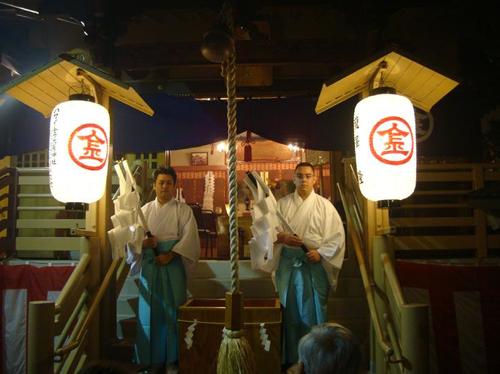
This morning New York City’s Landmarks Preservation Commission denied landmark status for 45-47 Park Place, the proposed location for Cordoba House/Park 51. If landmark status had been granted to the property, it would have prevented the owners, Soho Properties, from demolishing the current building in order to build a new Islamic center and mosque near Ground Zero—a controversial project recently covered here on the Tricycle blog. Though the project has been protested vehemently by politicians, talk show hosts, and even Sarah Palin, CNN’s Belief Blog points out the building is already being used peacefully by Muslims for prayer. This is not the first time that a religious group has been denied a space to practice due to religious intolerance stemming from a traumatic and violent local event. Following the Japanese bombing of Pearl Harbor during World War II, Japanese living in the area were persecuted, especially members of Shinto organizations—a Japanese practice which has heavily influenced Buddhism in Japan. From religion-online.org:
Japanese leaders, including Shinto priests, were rounded up and deported. It was impossible to resettle all of tImages: dnainfo.com and e-shrine.orghe Japanese, as California had done, for they constituted nearly one-third of the population. The people of Hawaii simply had to learn to live together despite their qualms. Suspicions continued for a while: Shinto shrines were considered a hotbed of subversive activities by some and were vandalized.
This climate of intolerance and anger led to the closure of Kotohira Jinsha-Hawaii Dazaifu Tenmangua, a Shinto shrine just five miles from Pearl Harbor. Though the shrine had been operating peacefully in the community for over twenty years, Kotohira Jinsha was forced to close its doors after their leader, Reverand Isobe, was deported to Japan. After briefly reopening without a priest, the shrine’s property was seized by the government in 1948 and soon put up for sale. Eventually, Kotohira Jinsha brought a lawsuit against the government. From the shrine’s website:
All religious and cultural activities were terminated as the war continued. In 1943, the interned Rev. Isobe was deported to Japan, forcing officers to call a special meeting on July 21, 1945 to decide the fate of the shrine. Kotohira Jinsha officially announced the temporary closure of the shrine and its activities on April 6, 1946. After the war, members enthusiastically restored shrine activities on December 31, 1947, despite the absence of a priest. However, the shrine faced another crisis on June 8, 1948, when its property was seized by the Federal Government. An emergency meeting was called and a special committee formed to initiate measures for the return of the shrine and its property. … The lawsuit by Kotohira Jinsha was the first ever initiated a Japanese organization in the history of the United States, paving the way for similar lawsuits by other Japanese organizations. On July 31, 1965, a stone memorial was erected in honor of shrine members who persisted against overwhelming odds in a lawsuit against discrimination by the Federal Government. It was also meant to serve as a constant reminder of the hardships and indignities suffered at the hands of a nation misguided by wartime hysteria, racial prejudice and fear, which we must not allow to happen again to any group, regardless of race, religion or national origin.

Since its reopening in 1950, Hawaii Kotohira Jinsha has operated peacefully as an integral part of the local community. As is the case with the resistance to both the Shinto shrine and the Ground Zero mosque, a pervasive feeling of vengeance often befalls areas that have undergone violent trauma. Frequently, those who share an ethnicity or religion with the attackers become the perceived enemy—even if they have lived peacefully and harmoniously in the community for many years. The story of the Kotohira Jinsha shrine should serve as a reminder that unwarranted intolerance and oppression is hateful, thoughtless, and often totally unfounded. To read more about the history of the Kotohira Jinsha shrine click here. UPDATE: An editorial on religious tolerance and the Ground Zero mosque appeared in Wednesday’s New York Times. Read the piece here.